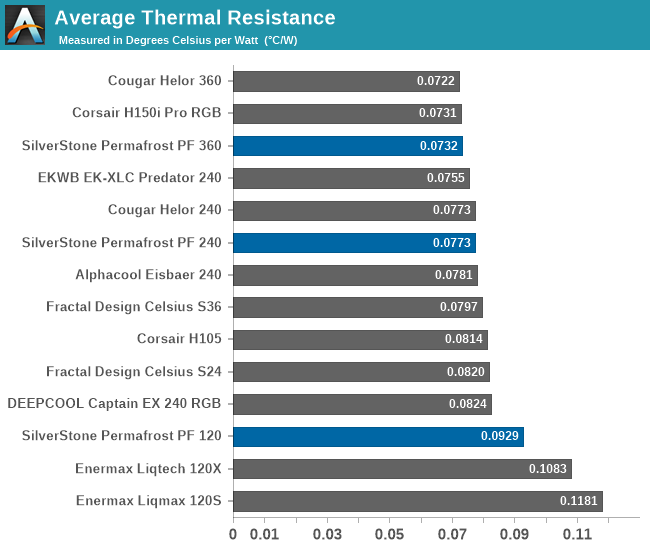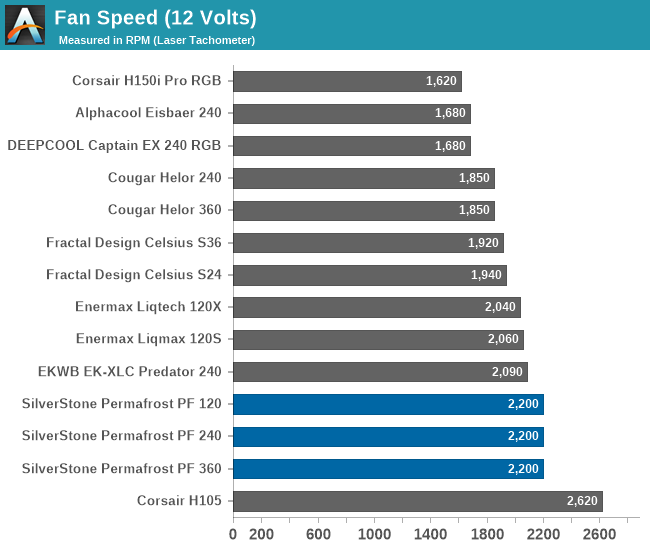The SilverStone Permafrost PF120, PF240, and PF360 ARGB AIO Coolers Review
by E. Fylladitakis on June 17, 2020 10:00 AM ESTTesting Results, Maximum Fan Speed
Our maximum speed testing is performed with both the fans and the pump of the kit powered via a 12V DC source. This input voltage should have the pump and fans matching the speed ratings of the manufacturer. As per SilverStone’s specifications, the fans should have a rotational speed of 2200 RPM. According to our tachometer, the speed of the fans is spot-on at 2200 RPM. Furthermore, the speed difference between the six fans we tested was negligible, indicating great manufacturing quality and minimal deviations.


| Core Temperature, Constant Thermal Load (Max Fan Speed) |
A glance at the average thermal performance charts reveals that the new SilverStone Permafrost coolers perform as expected of their size and technology. Their raw performance falls very close to that of similarly sized coolers, outperforming some and losing to others. The average thermal resistance of 0.0732 °C/W that the PF360 achieves is remarkable for any kind of CPU cooler, yet it does not break any records and is overshadowed by the impressive 0.0773 °C/W figure that the PF240 achieved. The smaller PF120 has a substantial performance gap compared to its larger counterparts but does perform well for a single 120 mm AIO cooler.

In terms of acoustics, SilverStone’s engineers did an excellent job. Despite that the fans supplied with the Permafrost coolers are relatively high-speed, the sound pressure levels of all three coolers are comparatively low. As a result, the larger coolers end up outperforming models that use one or even two fewer fans.











71 Comments
View All Comments
close - Thursday, June 18, 2020 - link
On topic: I'd still go with air on any system I plan to keep for a while. I have plenty of machines still operating just fine after close to a decade, I don't want to tempt fate with a liquid loop.Off topic, Germans don't seem to believe in A/Cs mounted on the outside of every building and the A/C noise that all neighbors have to live with. And I remember years ago my neighbor's A/C unit (not in Germany) keeping me awake at night because that hum and vibration would be heard and felt best in my bedroom. Also Germany wasn't the hottest, most humid of countries when they came up with the policies.
PeachNCream - Thursday, June 18, 2020 - link
Seattle has that same sort of problem. It only gets hot enough to really warrant AC a few weeks out of the summer during a typical year so most residential construction and some business structures lack air conditioning. The only time its a problem is for those few weeks of summer and when there is an unusual heat wave, but while living there, the point of keeping a PC that doesn't generate a lot of heat or require extensive cooling was sort of reinforced. My desktop made my bedroom feel warmer but my netbook was insignificant. It should be no surprise that I figured out how to stay connected, amused, and busy on just an Atom n270 at that point. :)khanikun - Friday, June 19, 2020 - link
I normally just go air for my non-main rig. One is a file server and just sits there, while the other is a backup gaming rig. That one usually just sits there too and I play videos on it, while gaming on my other machine.I think AIOs are fine, so long as you aren't constantly tinkering around in your machine. The more you mess with it, the more likely something on it might fail and cause leaking. Why I have them in my computers that I don't mess with much and have a custom on my main rig. The custom is a much more robust setup.
As for Germans and A/C, ya. They didn't bother with it, since it really wasn't all that hot and didn't last long. A fan would suffice, but with everywhere being hotter nowadays, people are definitely rethinking it. The last 3 years I was there, every summer the portable A/C units were sold out for the whole season. Peak heat only lasted like 2 weeks, then over time that changed. Went from 2 weeks to a month. Then a 1 1/2 months. Was also getting close to 100F.
Slash3 - Thursday, June 18, 2020 - link
I love how the top two best results in every graph on that page are air coolers.Slash3 - Thursday, June 18, 2020 - link
Haha, hoist by my own petard. They're all air coolers in those graphs.Flunk - Monday, June 22, 2020 - link
Not really, it's just dependant on the size of the radiator. AIOs can be made with later radiators than tower coolers, but it doesn't make AIOs magically better. It's just a matter of how much heat dissipation surface you have. If you get the heat there with heat pipes or pumped liquid is largely irrelevant.hansmuff - Wednesday, June 17, 2020 - link
Repeat after me: there are other benefits and they are worth it to some.eek2121 - Wednesday, June 17, 2020 - link
Baseless argument. I have been using AIOs for a long time and have never had a leak. One of my units is 6 years old and is used daily.WaWaThreeFIVbroS - Wednesday, June 17, 2020 - link
That doesn't mean others never had their AIOs leaked, my AIO leaked and broke the GTX 980 beloe it, never againPeachNCream - Thursday, June 18, 2020 - link
A single digit sample size does not make for reliable data on a statistical level so claims either for or against leak risks would really need a broader collection of data than we have the ability to gather here. That's why I don't really comment much on leaks aside from pointing out we haven't the right information. As far as I'm concerned, other more obvious factors are worth consideration beyond leaking or not leaking (though I do feel for someone losing expensive hardware due to a leak - kinda sucks).